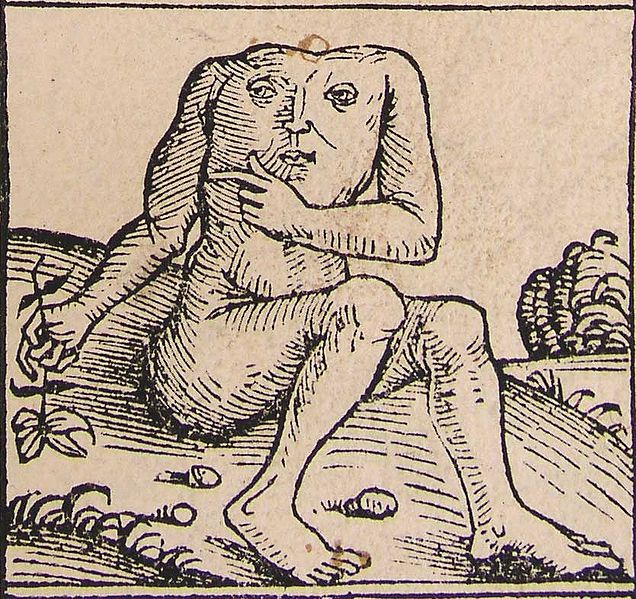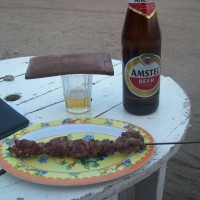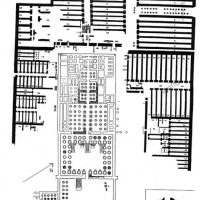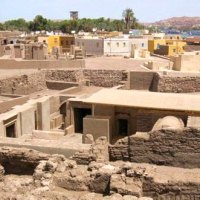Background:
For several years in the early 1980’s, while with an international humanitarian organization, I managed a livestock-health project working with several of the Bishariin –or Beja – tribal lineages who live in the Red Sea Hills of Southeastern Egypt and Northeastern Sudan (map below).

Beja moving camp. The long sword being carried by the man in front continues to be worn by all men once out of their camp. The rear camel is carrying a covered platform in which women, children or sick ride during long treks. – Source: © David Haberlah
This is the first of two blog entries on the Beja, based on my experiences and work at that time; since then, the Beja have – in comparison with other populations – been increasingly marginalized from political, economic and social services in both Sudan and Egypt. While remoteness is part of the reason, it is also because of their status as nomadic populations which, throughout history, have generally been dealt with as ‘backward’ and as groups that ‘need to be’ settled – often forcefully – by central governments as well as by well-meaning donors and humanitarian organizations. It is therefore not too surprising that Beja tribes in the Sudan are now engaged in separatist movements against the central government:

Since the mid 90’s, Beja of Sudan have been engaged in separatist movements. Source: Pulitzer Center
0 0 0 0 0
Following the second entry of this series on the Beja, I give the following recipes, which typify their resources and their cuisine:
- Beja Coffee Ceremony
- Camel Shins (Kawaari’a)
- Meat and Okra Stew (Bamyya)
- Ostrich Brochettes
- Salted Meat
(NB: All of my own photos taken in the area were lost; many thanks to persons who have supplied replacements.)

- Beja territory is shown in the lower right-hand corner; the blue-red line from Cairo shows the route that we had to take. The Oasis of Siwa, discussed in another blog, is shown in the upper left-hand corner.
The Red Sea Hills is an extremely rugged and remote region. Just getting to the project area took over 20 hours from Cairo by 4 wheel drive or large lorry – broken up into 2 days of 10 hours driving each. But it was worth the hardship, for the Beja continue practicing one of the most interesting and hardiest lifestyles known.


The Red Sea Hills are amongst the most rugged and spectacular ranges found in North Africa. In many places they rise abruptly out of the plain, providing seasonal water courses and sparse but good grazing on a seasonal basis. – Source: © David Haberlah
The area is exceedingly harsh – as these pictures show. Trees, other browse, and seasonal grasses have been carefully managed throughout the generations: traditional use rights limit over-exploitation, though this system has broken down since the droughts of the 1980’s. While Beja are pastoralists by lifestyle, there is now a scattering of settlements along the Red Sea coast, where modest supplies can be bought and where some Beja live semi-permanently, while others have settled in regional towns. As well, some Beja live in several regions along the Nile in southern Egypt where they have been traditional involved in the long-distance camel trade, discussed below.
As pastoralists, the Beja raise camel, goats and some sheep, and ply the lively camel trade between Sudan and Egypt, also selling meat and racing camels across to Red Sea Saudi Arabia. Their racing camels are considered amongst the fastest in the world – and their goats amongst the hardiest.

Camel racing is a popular sport. The camels have been carefully bred over generations, and the best are often sold to Saudi Arabia. Their confirmation & behavior are quite different from that of riding and pack camels.

Beja youth and camel

Local goat breeds are extremely hardy and capable of climbing trees to seek tender Acacia leaves. – Source: © David Haberlah
History:
The Beja are of Hamitic stock and speak their own language – to-bedawei – the largest unwritten language found in North Africa. Until about 5000 BC, the region was savanna and contained many animals that disappeared as the climate became more arid. The rock drawings shown here depict elephant, long-horned cattle, possibly a long-horned goat, ostriches, and several other animals. Until the area dried up, inhabitants herded cattle as well as goats and sheep, hunted other game, and perhaps grew a few crops during the wet season.

Rock art in the Red Sea Hills shows a wide variety of wild and domestic animals, as well as boats, that were found before late and post-Holocene climate changes.
With the exception of wild cattle and goats, various gazelle species, lions, hyenas, ostriches and a few other species, game moved further south in Africa as the region became drier. It is likely that the ostrich feathers used throughout ancient Egypt in the pharaohs’ crowns came from this area, and that ostrich feathers and eggs formed part of the trade between the Beja and the Nile valley.

Ostrich feathers and eggs being presented at court

Ostrich fan from the tomb of Tutankhamen
During pharaonic times, the herdsmen who were used in the care and movement of cattle that pastured outside of the Nile Valley in the Eastern Desert and Hills appear to be forebears of the current Beja:

Ancestors of the current Beja herding Nile Valley in the Eastern Desert
In 1847 BC, during the reign of Pharaoh Ammenemes III, there is a record in the Semna Dispatches (records of daily events in southern Egypt kept by the Pharaoh’s troops in Aswan, S. Egypt) that several nomads from the Eastern Desert came to the garrison, very hungry, and reported simply that: “The desert is dying of hunger!” They were turned away.
The earliest identifiable written records of the Beja are found in documents from the 4th Century BC in conjunction with their raids on the trade caravans coming into the Nile Valley from the African interior. These caravans brought many luxury goods into Egypt, including ebony, gum Arabic, exotic wild cats, monkeys, giraffe, and other items.
In later Roman accounts of these tribal incursions, the Beja are called ‘Blemmyes’. They are described as fierce warriors who extended their raids into the Nile valley, at one point capturing and holding ransom over 20,000 Egyptians. In the First Century CE the Blemmyes were described by Pliny the Elder, in his Natural History, as being headless. This description continued into Medieval and later times and there are a variety of representations of Blemmyes in European art, such as the following:

A blemmyae from Schedel’s Nuremberg Chronicle (1493)

wegnaarparadijs – ‘Capital with Blemmyes’, 12th century, Sint Servaaskerk
During the colonial (British) period ostrich feathers from the Red Sea Hills were in great demand for export to Europe. The birds were killed or captured in large numbers and feathers were shipped to London and elsewhere. Extensive killing of the birds led to their ultimate disappearance in Egypt and northern Sudan.

British colonialists attempted to raise ostriches for their feathers.
More recently, as noted above, the Southern Beja (in Sudan) have been increasingly engaged in hostilities against the central Sudanese government. Lack of basic social services, of education, and of employment opportunities – in addition to outright discrimination – are some of the given reasons:

Beja rebels on patrol. Source: Pulitzer Center
Lifestyle in an arid land:
Ancient, hand-dug wells, many meters deep, dot the region. Their access – as access to the land – continues to be guided by traditional use rights. Some of the most beautiful singing I’ve heard has been at these wells. Each well has its own ‘song’ – and when a group comes to water their stock, they sing the song in unison while jointly hauling up the leather bags filled with water – a very arduous task! As they haul in time with the pulls, their singing echoes off the walls of the well, producing a lovely effect. Unfortunately, the recordings that I made at a number of these wells were lost during many years of travel and shipments.

One of the many, hand-dug wells (front, left) throughout the area – this one is on the caravan route of Kanais that connects the Red Sea with the Nile Valley. In the background are ruins of a Roman fort, built for protecting trade caravans from marauding Beja tribes. – Source: Francis Lankester
The Beja follow the annual season with their herds. Familial groups break up into smaller traveling units, which stay in one area for 6 or more weeks, depending on pasture, before moving on. If passing or staying for any length of time within the territory of another group, they will first seek permission. It is a solitary life, and thus visitors are welcomed with joy, hospitality and always a coffee ceremony – described in the next post.

Temporary homes are sometimes built along the Red Sea Coast. © David Haberlah

Fuel wood being taken to the home camp. By 1980 fuel was so scarce in the area that some people were illegally digging up roots of trees, then covering the holes – a practice that resulted in the deaths of many, many trees. – Source: © David Haberlah
Housing is simple – it must be light, easy to transport and easy to assemble. Tent-like constructions are generally made of woven mats that can be rolled up and carried by camel or donkey. A simple, bed will be constructed in the interior. Semi-permanent settlements near the Red Sea are generally constructed of wood.

Interior of a Beja tent.
Continued Here: A brief description of our project work with the Beja and some recipes.



























Pingback: Locusts and Hyenas: The Red Sea Hills of Egypt & Sudan | DIANABUJA'S BLOG
Pingback: Natural Environment of Egypt & Mohammed Kassas « DIANABUJA'S BLOG
Pingback: Tree breeds|Tree Species|Tree Breeding
Pingback: The Day Sadat was Assassinated « Dianabuja's Blog
Pingback: Most Popular Blog Pages – Why?! « Dianabuja's Blog
Pingback: Coffee Rituals, Camel Shins & Ostrich Brochettes: The Beja Tribes of Eastern Sudan & Egypt – Part II « Dianabuja's Blog
Why are the faces drawn on the bodies rather than having separate heads in both of the art pieces below, Diana?
LikeLike
Karen, good question that requires a long’ish answer, which I will put up as a blog entry.
LikeLike